So, you’ve been trying to rank on Google for a while now, but you can’t seem to understand how you can rank in the algorithm as well as your competitors?
Since SEO has so many moving parts, it can be a pain to try and figure them all out.
How do I conduct an audit on my site? How do I make sure my Onpage-SEO is on point? How many backlinks do I need to build to rank for my target keyword?
There is a mean learning curve when it comes to SEO and it’s the reason that 90.63% of all pages on Google get no traffic.
This means 847,833,932 pages are getting no traffic. Are your pages included in that?
This leads to a lot of aspiring site owners giving up before they’ve even had a real chance to succeed.
There are two ways you can improve your search rankings:
- Better keyword research
- Backlinks
Doug has an awesome guide on 8 unusual backlinking strategies, which is a great way to start securing some high-quality backlinks. In this guide I’m going to dive into how you can improve your keyword search results just by finding the right long-tail keywords.
If you’re ready to dive in, let’s do this.
Why Focusing On Long-Tail Keywords Should Be A Priority If You Have New Site
If you’ve been building sites for any amount of time, you know that Google shows no love to new sites. The best way to describe how Google looks at a new site is by looking at the graphic here.

It’s a catch twenty-two. In order to get traffic, you need authority, but in order to be looked at as an authority, you need to have traffic.
This is the cycle that you’re stuck in for the first 6-9 months when you start a website, which we all know as the Google sandbox.
What if there is a way to potentially “skip” this period of time and have your site bringing in traffic by week 12?
This is where the beauty of long-tail keywords really comes in.
Finding long-tail keywords, the keyword golden ratio has specifically helped me, and a number of my clients not only bring in traffic 2x as fast as our competitors but rank above some pretty high authority websites.
It makes the above graphic look more like this…

KGR’s sort of spark a pattern interrupt and helps to be able to obtain quick rankings, which then leads to traffic, ultimately leading to authority.
I want to break down step-by-step how I conduct my keyword research to improve my search results.
How I Find Low Competition Keywords
While there are plenty of low-cost options out there to use for your keyword research tool, my favorite by far is Ahrefs, so that’ll be what I demonstrate with.
Before you begin, I would say try to eliminate the preconceived notion that you have to go for the keywords with the most volume. This is not at all true.
In fact, longer tail keywords usually convert much higher than bigger general terms. I mean you tell me, which audience is going to buy from you?
The one that searches “basketball shoes”? Or the audience that searches “basketball shoes for wide feet”?
Using a Seed Keyword
When I do keyword research, I start with a seed keyword.
If you have a niche site, I’d recommend starting in one category and building that out first.
For this example, let’s say I have an outdoor niche site.
I would choose a category on my niche site, like “tents.”
Then search that keyword in Ahrefs with the modifier “best” in front of it.
I would then choose “Phrase match.”
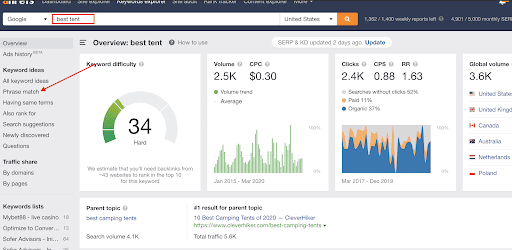
Here is where it gets a fun because you can start playing with filters. I usually find KGR’s by just adjusting the “word count” filter.
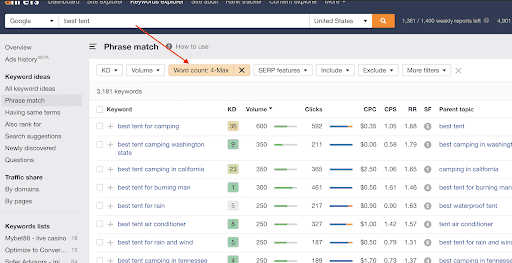
With location-based terms, it’s as simple as using the “exclude” filter to remove those.
Also, don’t be afraid to play with filters. Try a minimum word count of five or six and see what you can come up with.
Another way to do this is to look under the “Having same terms” section.

In this section, you’ll also have a lot of great potential low competition terms to target as well.
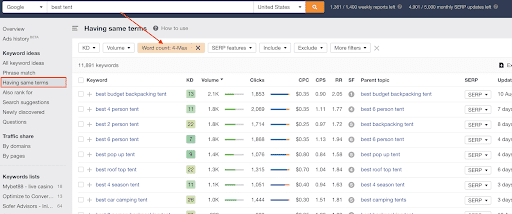
Move around with the “volume” filter as well. You can start out targeting keywords that fit the KGR exactly, meaning a 250 and under search volume.
I’ve found plenty of keywords within that search volume as well as over it.
Take this strategy and perform it with every category/product you’re reviewing on your site to come up with a ton of keywords you can start creating content around.
Intent Matching > Keyword Matching
Matt Stormoen, Co-Founder & CEO of Mobibi
Intent matching matters a lot more than keyword matching, but intent matching mostly gets passed over for keyword matching.
Today, no credible SEO would tell you to create separate pages for blue watch and blue watches and blue watch accessories. Instead, SEO is about figuring out what issue, function, or feature the searcher is looking to find.
If many keywords share the same intent, we’re going to create a single page that serves the intent and covers all of the keywords or at least many of the keywords that the intent is represented by.
Pro Tip: Using Google Search Console
Josh Imhoff, Always Relevant Digital
Once your page is live for a month, open up Google SearchConsole and see what keywords the page is ranking for. Sort the page’s Queries PerformanceReport by impressions and position to find long tail keywords that the page isranking for.
If there are a good amount of impressions for a term and theposition is less than about 20, it might make sense to retool the article toinclude a section explicitly covering the new long tail keyword.
Pro Tip: Internal Links
Sarah Blocksidge of Sixth City Marketing
Build internal backlinks to your site and be sure to link from text that is relevant to the page and your desired keywords. Not only is it good for SEO, but also helps your site be better read by those who use accessibility tools.
Using Competitors
This is one of my favorite strategies because you can really get those hard-to-find keywords that can slip through the cracks just by seeing what your competition is ranking for.
With this strategy, the bigger the competition, the more chances you have to find keywords.
I usually start this off by searching for a high competition keyword.

I’m going to grab outdoorgearlab.com because I know this is a high authority site with plenty of content.
Next, place the URL into the Ahrefs “site explorer” and then go to the “organic keywords” section.
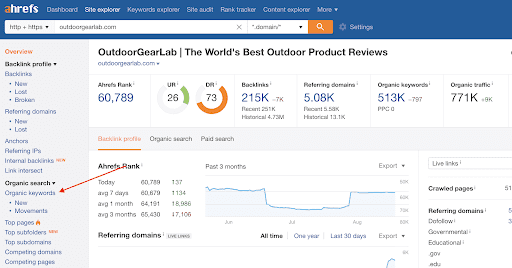
Now, this is where we can use the filters again as we did with the first strategy.

Now you have pages and pages of potential keywords you can target.
You may be thinking, “How can I outrank a big authority site like this?”
Well, just because a site is ranking for a term, does not mean that it was intentionally trying to.
This means that if you create a piece of content around this topic specifically, you can most definitely outrank a higher authority website.
Create a list of five to ten authority websites and run them through this process. You’ll find a bunch of keywords for your website.
These are the two main strategies I use to find not just commercial content for niche sites but informational content for e-commerce blogs as well.
Pro Tip: A marketing CEO’s tip for better search results
Optimize your website for voice searching and Google Assistant pulls.
Claim or update your information on local platforms like Google My Business, Facebook, and Yelp. This will not only improve your chances of being a top result for local voice searches but will give your site more authority in the search engine’s eyes.
Consider long-tail keywords for these searches as users will be looking for specific results when using voice rather than browsable options as they might at their desktop.
Eric Sachs, CEO @ Sachs Marketing Group
Pro Tip:Work Smarter, Not Harder
The fastest way to improve your rankings is to look at your existing keyword estate and shortlist keywords that fall into positions 10 to 30 in search results. These are keywords you may be able to bump up the SERPs relatively easily with small on page optimizations or a few backlinks.
Look at the competition for each keyword and prioritize your shortlist according to search demand and the weakness of competing pages in the results for them.
Paul Franklin from SideGains
Google Auto Suggest
I’m sure we can all agree that Ahrefs is super expensive, especially when you’re first starting out.
The Google Auto Suggest strategy is a killer strategy that a lot of people overlook because they think the keywords don’t have searches, which is completely not true.
I use this strategy the same way I would the first strategy we talked about but just let Google Auto Suggest do the work.
Start by taking your seed keyword with a modifier and placing it into google. Start typing in one letter at a time.

You can be more specific by adding in other words that make sense. For this example, I added the word “small.”

Try using different modifiers, in the case of this example, I would use ones like “big,” “small,” “pop-up,” “large,” etc. See where I’m going with this?
Pro Tip: Use a cheap keyword tool like Keywords Everywhere so you can see the volume while you’re doing this strategy.
I just recently used this strategy to find over 200 keywords in two days for a niche site that I was about to start in the health space, but wound up selling the keywords before I could even begin building the site.
What About Informational Content?
As affiliates, we love to focus on the commercial content because that’s what directly makes us the money, but informational content is just as important.
The way I find informational content works almost the same, let me show you two ways I do this.
So, in Ahrefs I’ll take my main seed keyword and do a search. Again, this would be “best tent”.
Then, I will go straight to the “Questions” section.

When it comes to informational content, I don’t care too much about super quick rankings, mainly because I know this content won’t make me money on the front-end (unless you’re a part of an ad network), but it definitely can on the back-end.
If you wanted to find some informational KGR’s, once in the “Questions” section, just start scrolling through and see what you can find.
I find that using the filters isn’t as necessary in the “Questions” section because a lot of these keywords are naturally longer tail, being that they are specific questions.
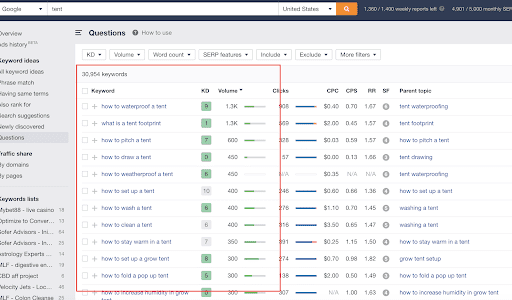
If you’d like to be certain you picked up on every informational keyword you could find, just go back to the “Keyword Explorer” and go to the “Phrase match” section and type a modifier in the “Include” filter.
Some modifiers for informational content that I like to use are:
- Who
- What
- When
- Where
- Why
- How
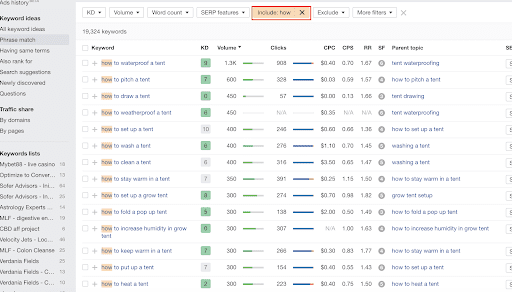
You may see a lot of the same keywords you see in “Questions,” but you may find a few in there that you may have missed as well.
Another way to find informational keywords is by revisiting the second strategy we talked about in this guide but using it for informational content instead of commercial.
I would take outdoorgearlab.com and place it into the site explorer and head to “Organic keywords.”

Make sure to do this with every modifier listed above so you can have a nice long list of search terms to target.
You see my complete process of how I find KGR keywords, both commercial and informational, I want to tackle some common hiccups when starting or expanding your site.
What To Do If It’s Difficult To Find Products To Write Commercial Content Around
One way to improve your keyword search results is to make sure your site is correctly categorized for topical relevance.
I can’t tell you how many times I come across a niche site owner that was confused about what exactly they should be reviewing on their blog and how to categorize it.
If you’re stuck at this point, here is a great tip that has helped me since beginning my journey in niche site creation about four years ago.
Visit a big e-commerce store in your niche and you will find some of the most neatly detailed categories that you’ll come across. Since we’re using the outdoors niche as an example, let’s take a look at REI.com
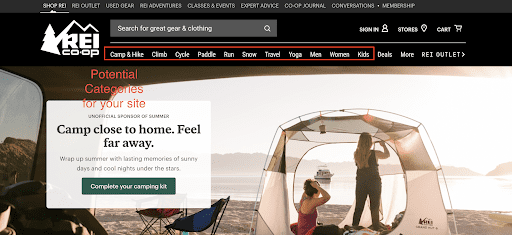
Not only can you get amazing high-level categories from e-commerce stores, but you can also get killer sub-categories for your own e-commerce or niche site.
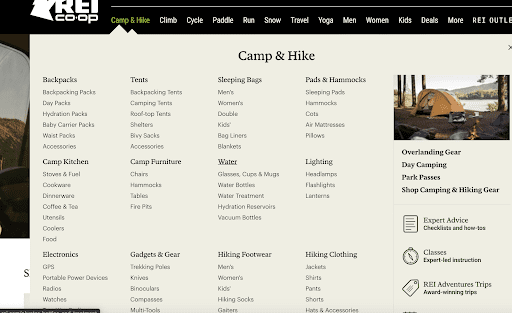
Here is a ton of products you can create both commercial and informational content around. Amazon is not the only way to find great products for your site.
Pro Tip: Using LSI Keywords
David from Outsmart Labs
One quick and easy way to improve your keyword rankings is to look at Long Semantic Indexing Keywords. These are the keywords that Google shows you at the very bottom of a search result, and they appear as “Searches related to.”
You can basically Google search whatever your base keyword (or topic) is and then scroll down to get a few ideas of some closely related words that would be a great compliment to your content. Doing this will help Google understand better what your page is about and you’ll be able to rank for your keywords AND Google’s suggested keywords.
Pro Tip: Ignore Search Volume
Chelsea Roller, Rank Fuse Digital Marketing
Shoot for keywords regardless of search volume—unless there is NO search volume. If you can rank in the top five for a dozen or so low search volume keywords (less than 100 or so searches per month), Google will eventually take notice and start ranking your content for higher search volume keyword phrases that you are using. Plus, keywords with low search volumes generally have less competition!
What To Do If It’s Hard To Find Authority Sites In Your Niche To Develop a Keyword Strategy From
This can be an issue as well, especially if your topic is very niche, but here is something you can do to find more popular websites in your space outside the earlier strategy I showed you.
So, you remember before when I told you to go to Google and type in a high competition term to find authority sites right?
Well, here’s something else you can do to find more authority sites using Ahrefs.
Once you have found at least one high authority site, go to “Site explorer” and search “Competing domains”.
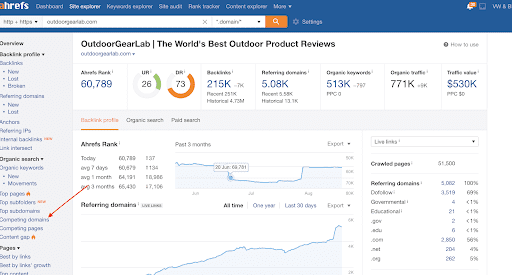
Then you’ll have a complete list of other domains that are similar in terms of topic and authority for you to use during your research.
Stop Reading, Start Researching
That’s it.
These are the exact strategies that I have used over the past four years to not only start and sell seven niche sites over the past two years.
Having that first coaching call with Doug at the beginning of 2017 and learning from him ever since has blossomed into an entire business and a new way of thinking about content marketing.
But I didn’t just learn and sit. I learned, took action, made mistakes, and grew.
Will you keep reading, or will you start researching some keywords for your niche or e-commerce site and become the next success story?
Lashay Lewis has been using the Keyword Golden Ratio for a while with great results — selling seven niche sites over the past two years. I coached Lashay back in 2017. I asked Lashay to write about improving your ranking in Google for a given keyword.
How to Improve Keyword Golden Ratio Post Ranking
I got a question about Keyword Golden Ratio…
“My brand new site is 3 weeks old and the KGR is ranked at 16. How do I move it up in the search? Any tips?”
If you are unfamiliar with Keyword Golden Ratio (KGR). It’s essentially the supply and demand for keywords. You can rank your keywords without backlinks.
Get my personal KGR Calculator Spreadsheet right here…
The KGR is this…
The number of Google results that have the keyword phrase in the title divided by the local monthly search volume (LMS), where the LMS is less than 250.
If the KGR is less than 0.25, then you should rank in the top 50 or so when your page is indexed.
You should still rank in the top 250 when the KGR is between 0.25 and 1. And it should be pretty fast. You can learn more about the Keyword Golden Ratio here.
So, because this ratio helps to rank your site in Google, it makes it SUPER important when you are trying to get traffic to your site.
And of course, in turn, get more sales and have a profitable site.
In my video How to Improve KGR Post Ranking, I answer a question about this ratio. Or keep reading…
The question was this:
“My brand new site is 3 weeks old and the KGR is ranked at 16. How do I move it up in the search? Any tips?”
That’s a specific question but these ideas will help even if your site is older or if your post is ranking higher or lower…
Be Patient
As time goes on, in my experience the ranking will move up a little bit. Even if you don’t do anything to build links.
So, I wouldn’t worry about that too much. It’s only been 3 weeks and that’s NOTHING.
I know when my first site was three weeks old, it was a total, utter MESS. You should be in this for the long haul. Your patience will be rewarded.
Engage With the Community
Next, and the most important tip is not to do more research, but to engage.
We can think about engagement in terms of this:
Engagement -> Increased Site Traffic -> Profit
When you are trying to get traffic to your site and improve your ranking, engaging in the community is a key component for this.
Finding blogs that are in your niche that aren’t direct competition. Go comment on those blogs and get some links.
Add More Content or Improve Content
This will be the MOST effective thing to do in the short term. You can use the RPM or FAQ Method to help get your creative juices flowing.
Both are fool proof outlining methods. You can use the outlines to write the content yourself or hire a writer.
If you add more content, you get at least 3 benefits:
- Help the visitor get more information.
- The post may rank for more long tail keywords, thus bringing more traffic even if the rankings don’t move…yet.
- It’s a sign to Google that the content is being appended, updated, and improved. Longer blog posts tend to rank higher in the search results.
Promote the Post, i.e. Get Backlinks
You should build backlinks if you’re less patient. The backlinks will send good, positive ranking signs to Google so you can rank faster, at least potentially.
Reach out to the people that you found in your blog commenting campaign and ask for a guest post. If you are having trouble with guest posting, you’re not alone, but keep at it and you’ll find that it’s not impossible.
More tips on the KGR
Watch my video here for a in depth conversation about KGR and my #1 tip on how to improve it.
Remember, these things do take time. Focusing on the keywords, content, and engagement will only increase your likelihood of success.